Specifications
|
SOUTHAMPTON
|
EDINBURGH
|
Displacement:
|
11,350 tons full load (original),
?? tons full load (revised)
|
12,675 tons full load
(original), 14,930 tons full load (revised)
|
Dimensions:
|
180 x 19 x 6 meters (591.5 x 62 x
20 feet)
|
187 x 21 x 7 meters (613.5
x 69 x 23 feet)
|
Propulsion:
|
4 shafts, Parsons geared steam
turbines,
8 Admiralty 3-drum boilers, 75,000 shp,
32 knots
|
4 shafts, Parsons geared
steam turbines,
8 Admiralty 3-drum boilers, 80,000 shp,
32.5 knots
|
Armour:
|
Belt 4.5"
Deck 1.5"
Magazine 1" - 4.5"
Turrets 1"
Bulkheads 2.5"
|
Belt 4.5"
Deck 1.5" - 2"
Magazines 3"
Turrets 2" - 4"
Bulkheads 2.5"
|
Crew:
|
750
|
710
|
Aviation
Seaplanes
|
Originally fitted to carry two seaplanes.
|
Surface Action
|
SOUTHAMPTON
|
EDINBURGH
|
Guns:
|
4 - 6"/50 Mk.23 triple mounts (X
mount removed from
GLASGOW, SHEFFIELD, and NEWCASTLE)
4 - 4"/45 QF Mk 16 HA dual mounts
2 - 21" triple torpedo launchers
|
4 triple 6-inch / 50
Mk 23 triple mounts
4 - 4"/45 QF Mk 16 HA dual mounts
2 - 21" triple torpedo launchers (removed)
|
Radar:
|
? Type 293Q surface / low
level air search
? Type 974 navigation
|
? Type 293Q surface
/ low level air search
? Type 974 navigation
|
Fire Control:
|
? 2 - 6" DCT with Type 284
|
? 2 - 6" DCT with Type 284 ?
|
Air Defence
|
SOUTHAMPTON
|
EDINBURGH
|
Guns:
|
4 - 4"/45 QF Mk 16 HA dual mounts
4 - 40mm twin mounts (possibly 6?)
? - 20mm ?
|
4 - 4"/45 QF Mk
16 HA dual mounts
4 - 40mm Mk.5 Bofors twin mounts (1959-1963, 6 - 40mm twin)
? - 20mm ?
|
Missiles:
|
none
|
none
|
Radar:
|
? Type 277Q height finder
? Type 279 air warning
|
? Type 277Q height
finder
? Type 279 air warning
|
Fire Control:
|
? HADT Mk.VI with Type 275 (later
2 - Mk.6 HA directors)
|
? 8 - MRS8 AA directors
|
Undersea Warfare
|
SOUTHAMPTON
|
EDINBURGH
|
Armament:
|
none
|
none
|
Sonar:
|
??
|
??
|
Electronic
Warfare
Attack:
ESM:
ComInt:
Ships:
Name
|
Pendant
|
Completed
|
Comments
|
Fate
|
|
SOUTHAMPTON CLASS
|
SOUTHAMPTON
|
|
1937
|
|
Sunk, January 1941.
|
BIRMINGHAM
|
C 19
|
1937
|
Paid off, 1959.
|
Scrapped, 1960.
|
GLASGOW
|
C 21
|
|
Paid off, 1956.
|
Scrapped, 1958.
|
SHEFFIELD
|
C 24
|
1937
|
Paid off, 1959.
|
Scrapped 1967.
|
NEWCASTLE
|
C 76
|
1937
|
Paid off, 1948.
|
Scrapped 1959.
|
EDINBURGH
CLASS
|
EDINBURGH
|
|
1939
|
|
Sunk, 1942.
|
BELFAST
|
C 35
|
1939
|
Refitted, 1956-59. Paid off, 1971.
|
Museum, 1971.
|
Note: SOUTHAMPTON and EDINBURGH were presumably sunk before
they could be issued with Pendant numbers.
Photos:
(click on thumbnail for bigger image)
The first four
photos are of SHEFFIELD, a member of the original SOUTHAMPTON class.
|

|
SHEFFIELD laid
up sometime between 1963-1967. All her equipment still seems to be in place,
although a number of guns, sensors, and the funnels are covered. During this
period, she was serving as a harbour accomodation ship, which is reflected
in her good appearance. M.D. Thomas photo.
|
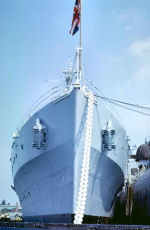
|
A bow-on view
of SHEFFIELD. M.D. Thomas photo.
|
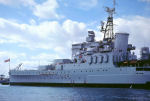
|
Port bow view
of SHEFFIELD. Note the main battery fire control system (6" DCT with Type
284?) atop the bridge, with a secondary fire control system (Mk.6 HA?) on
the port superstructure adjacent to the forward funnel. A twin 40mm mount
is forward of this, and possibly a smaller mount (20mm?) ahead of that. Height
finder and surface search radar antennas can be seen on the mast above. Also
note the life rafts fixed to the side and aft end of the superstructure.
M.D. Thomas photo.
|

|
Port midships
view of SHEFFIELD. Note the forward port twin 4" gun to the right of the
photo, as well as what is possibly another 40mm twin mount above and to the
right of that. A crane derrick is visible between the two masts; this is
where seaplanes would originally have been carried. The life rafts
visible in the previous photo have now been removed, indicating this photo
was taken later. The funnel behind SHEFFIELD belongs to the stores ship RAME
HEAD. M.D. Thomas photo.
|
The
remaining photos are of BELFAST, an EDINBURGH class ship. The first batch
were taken recently, and show her as she appears today. Some older shots
follow, to show how restoration efforts have progressed.
|
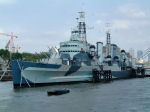
|
Port bow view
of BELFAST, as she appears today on the Thames in London. BELFAST went through
a maintenance period in 1999, which saw her painted in the camoflage patterns
seen here (as she appeared at the Battle of North Cape, December 1943), and
some additional equipment was replaced which had been removed before she
became a museum. A and B turrets are elevated to maximum, and are ranged
upon a motorway service station. M.D. Thomas photo.
|
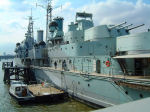
|
Port side looking
forward. Note the aft main battery fire control system (6" DCT with Type
284?) situated above the X gun mount (A and B are the two forward 6" triple
mounts, X and Y the two aft 6" triple mounts, in order from bow to stern).
Although various members of the SOUTHAMPTON class had their X mount removed,
BELFAST retained all her main battery, and the aft mounts were actually situated
one deck higher than in the SOUTHAMPTON class. Immediately in front of the
funnel, there is a secondary (AA) battery fire control unit (MRS8?) along
with a twin 40mm gun mount. The covers on the fire control units make it hard
to properly identify them. M.D. Thomas photo.
|
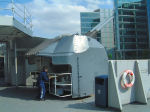
|
A twin 4" mount
on the port side. M.D. Thomas photo.
|
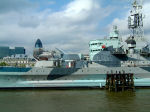
|
The formard main
battery and superstructure. M.D. Thomas photo.
|
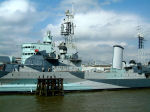
|
After 1959, 6
sets of 40mm twin mounts were added to the forward (4 sets) and rear (2
sets) superstructure, but the two aft sets on the forward superstructure
were removed in 1963. These mounts seem to have been replaced during the
1999 refit, and are visible here. Aft of the second 40mm mount is one of
the forward port MRS8? fire control units. The main battery fire control
and radar antenna on the mast above seem to be identical to those fitted
on SHEFFIELD, as noted above. Note that BELFAST's two funnels are located
further aft than those on SHEFFIELD, and the crane derrick is actually located
forward of (instead of aft of) the forward funnel. Again, this would have
been where the seaplanes were originally carried, and where launches and
other boats were kept after the seaplanes were removed. The M.D. Thomas photo.
|
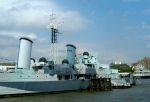
|
Looking aft along
the port side. Atop the aft mast is what appears to be a Type 279 air warning
radar antenna, although this set was supposed to have been obsolete long before
BELFAST paid off. M.D. Thomas photo.
|
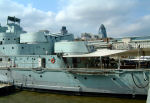
|
The aft main battery.
M.D. Thomas photo.
|
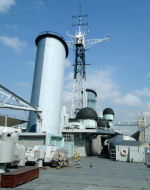
|
Port side, looking
aft. M.D. Thomas photo.
|
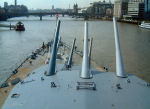
|
Looking forward
from the bridge over the forward triple 6" gun mounts. M.D. Thomas photo.
|
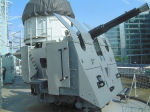
|
A Bofors Mk.5
twin 40mm mount, with a covered MRS8? fire control unit in the background.
M.D. Thomas photo.
|
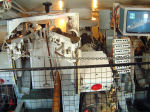
|
This photo shows
the centre breach of A turret. M.D. Thomas photo.
|
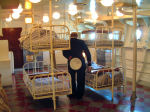
|
A Surgeon Lt.
Commander on his medical rounds in the ship's sick bay. M.D. Thomas photo.
|
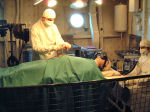
|
An operation mock-up
in the ship's operating room. Contrast this with the original mock-up,
which is pictured below. M.D. Thomas photo.
|
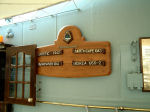
|
BELFAST's Battle
Honours. M.D. Thomas photo.
|
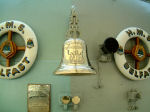
|
The ship's bell.
M.D. Thomas photo.
|
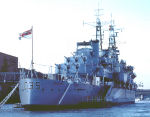
|
An older view
of BELFAST, taken off the starboard stern. This photo was taken within a
year or so of BELFAST being moored in the Pool of London. M.D. Thomas
photo.
|

|
An aerial view
of BELFAST, taken from the Fire of London monument. Note the missing 40mm
twin mount from the aft position on the forward superstructure. M.D. Thomas
photo.
|
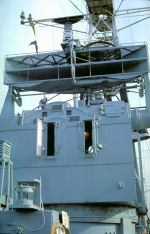
|
A close up of
the forward main battery fire control tower (which is assumed to be a 6"
DCT with Type 284), with a radar antenna possibly belonging to the Type 974
DECCA navigation radar set. M.D. Thomas photo.
|
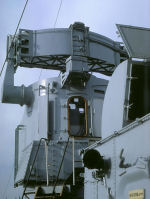
|
The aft end of
the 6" DCT with Type 284 fire control tower. M.D. Thomas photo.
|

|
The original mock-up
of the operating room. M.D. Thomas photo.
|

|
This shot was
taken within one of the inboard engine rooms, with what appears to be a
partially dismantled steam turbine in the background. M.D. Thomas photo.
|
|

